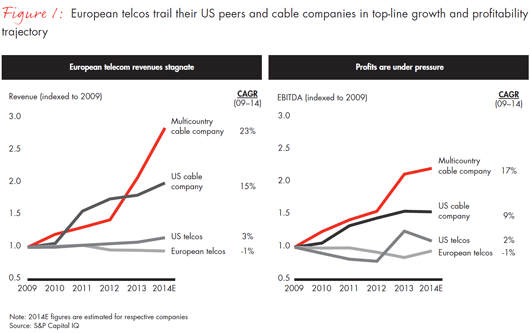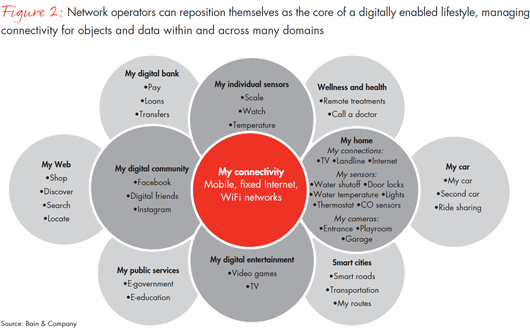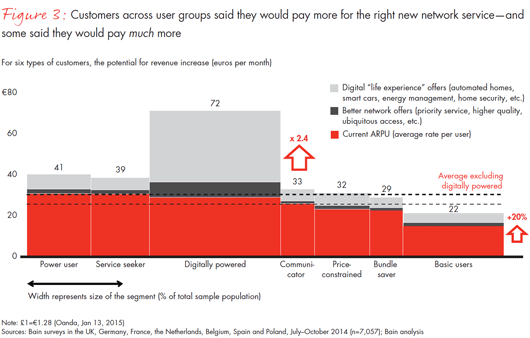Etude
Telecom operators in Europe—especially mobile operators, but also fixed wireline—have competed on price for at least a decade. In each domestic market, three to five companies engaged in a massive fight for market share, driving down prices for network services (voice, text and data) and devices, which operators subsidized to help poach customers from one another.
This focus on price has taught customers to make price the main criteria for their choice of operator, far beyond other factors like network quality, brand or services. The price war has increased the penetration of mobiles (more than 100% in some European markets, since some people have more than one device) and fixed broadband, but has also eroded value for telecom operators. Cable providers, which have maintained higher prices thanks to the perceived value of their entertainment content, have escaped this fate.
As connectivity costs have fallen, customers have begun to think of telcos as mere providers of pipes and have shifted their perceptions of value from the network to their mobile devices and content providers. Interestingly, customers began to think of networks as a commodity at the very moment when network quality was becoming essential to their digital lifestyles. Telecom operators facilitated this perceptual shift, delivering marketing messages about price, promotions, mobile phones and over-the-top content brands, rarely bothering to educate customers about the investments and innovation required to deliver quality network service. Regulation has accelerated these trends, keeping prices low and competition high.
This focus on price has depressed revenues, earnings and cash profiles of most operators over the past five years, making it harder for them to invest in new technologies like fiber or 5G, or to build up dense networks of access points necessary to handle ever-increasing data loads (see Figure 1). Clearly, telecom operators need to shift their marketing strategy beyond price-defined networks. North American telcos have been more successful at enunciating the network’s value for customer experience and performance, but Europe’s telcos have some catching up to do.

Fortunately, we see signs of hope: About one-third of customers surveyed in seven European countries in 2014 said they would spend more on network services for a different kind of connectivity. This is encouraging evidence that network operators can generate more value from their networks if they take the right steps. Customers depend on network services now more than ever, relying on them for “mission critical” activities like financial transactions, home automation, security, health monitoring, connected cars, traffic information and energy monitoring. More social relationships have moved online, and many consumers depend on network services to stay connected with friends, family and communities (see Figure 2).

But as consumers become more aware of malware, hacking and other security threats, they also worry about protecting personal data stored in the cloud. Their basic communication needs (voice, text messaging) remain important, but now these needs are only part of the picture. Customers also expect to be connected anywhere—at home or away— and anytime by mobile or fixed networks, and most don’t care how the operators manage it.
It’s time for operators to educate their consumers about the value of the network and its central role in a digital lifestyle— and to transform their organizations accordingly.
Exploiting a window of opportunity
The convergence of two trends—consumers’ increasing dependence on a digital lifestyle empowered by networks and the rise of new network technologies that will help telcos deliver better service—make this the opportune moment to “repremiumize” the perception of the network’s value. Resetting customer perceptions won’t be easy, but leaders must take this path to deliver new topline growth that will fund investments in infrastructure and ensure long-term economic viability.
Network operators need to do several things:
Invest in their networks. First, they need to allocate Capex selectively, in ways that enhance their customers’ digital experiences. Among operators’ user groups, one in particular—those we call “digitally powered”— say they would pay more for new services like better connectivity and monitoring of sensors and other connected objects (see Figure 3).

New technologies based on software-defined networks (SDN) and network-function virtualization (NFV) will enable telcos to deliver premium experiences to customers. These advanced network technologies can optimize performance for individual users based on their unique needs—for example, by dynamically increasing speed or bandwidth as needed. Most users won’t be aware of the underlying technology but should notice a more seamless experience.
Some customers will want only low-price connectivity, but others will pay more for network service that responds and adapts to their demands. Telecom operators will need to upgrade their network intelligence layers to provide this type of differentiated service.
Leading telcos will also provide cloud services, often through partners, to make it easy for their customers to store and access the elements of their digital life, from personal data and media to authentication and other services.
Reset marketing focus. Telcos will need to reorient their marketing strategies away from features and prices, and reposition their brands as enablers of consumers’ digital lives. In practical terms, this means creating new marketing concepts that differentiate operators from competitors and clearly communicate benefits based on experience rather than on price and features.
GoPro has accomplished something similar in digital photography. It carved out a premium position not only by marketing its cameras’ ability to capture extreme sports (and by selling them near the action, in ski and surf shops), but more important, through the experiences the camera captures. GoPro cameras may feature video over WiFi and a waterproof case, but their real appeal lies in helping the buyer become a hero. In the same way, mobile 4G speed is an important feature that becomes even more valuable when consumers perceive the differential improvements it makes to their digital life experiences.
Communications showing the user experience will not appeal to all customers. Some will want to continue paying low prices for connectivity that is simply good enough, while others will pay almost twice as much for more advanced network services. Network providers will need to supply and market a range of service levels at different price points. At the same time, they should strive to keep their choices and customer interfaces clear and simple by avoiding the complexity of too many offers, which customers have struggled with in the past.
Differentiate the value proposition. Past attempts to restore premium value have failed, as competitors have either adopted similar service improvements or lowered prices. Now, consumers’ growing awareness of their dependence on the digital environment combined with new enabling technologies have created a window of opportunity for leaders to leap over slower-moving rivals. Market leaders have a stronger position for promoting this perceptual shift, as their scale allows them to deliver consistent and persistent marketing messages to more customers. However, some challengers with the right infrastructure and customers may also succeed, particularly in markets with slow-moving incumbents.
Transforming the company
A transformation of this scale requires more than a strong lead from marketing. Senior executives must orchestrate a cross-functional effort that combines the marketing reset with the changes necessary to deliver on a premium value proposition.
- Strategic shift. Redefine telcos as the enablers of an integrated, premium digital lifestyle. Deliver consistently over time and stand apart from other providers through content and other over-the-top services that depend on networks. Brand positioning and strategy must lead this shift.
- Operating model. Unite sales, marketing and technology teams (both network and IT) to understand and deliver the services that will help customers realize the value of networks through simple, powerful marketing propositions. Technology, marketing and sales functions will coordinate and set priorities closely together.
- Packaging the customer promise. Learn to describe the ways that network services enable a premium digital lifestyle, showing consumers not only entertainment and communication, but also the experiential benefits of smart and connected homes and cars, security, healthcare and other digital services. Focus on the things that provide the greatest value to both customers and operators.
- Network Capex prioritization. Define the strategic roadmap, from fixing basics to delivering a truly differentiated experience. Invest differentially in the elements that will deliver the most value, based on the customer context and expectation of user experience. Gain a better understanding of the ways customers use networks, a holistic picture comprising context, time, location, device and purpose. Policy management in the core network and intelligence layers will enable different experiences for customers using the same network.
- Commercial reset. Revamp the sales experience from selling others’ products (for example, selling ancillary features, subsidizing devices or pushing promotions) to one that reflects the network’s value. Partner with security, navigation, storage and content providers, but in ways that do not diminish the network to a commodity role. Rather, use networks to empower other industries to deliver their services to customers, too.
- Digitization. Leverage advanced data analytics and data provided by connected sensors and the Internet of Things to identify trends from low signals, and find new roads to market, from go-to- market adjustments to new premium business models. Use better real-time monitoring and predictive anticipation of consumers’ behaviors on the networks to help improve the customer experience.
- Execution and mobilization. Execute persistently and resiliently over a two- to three-year period. Only the CEO has the power to build a premium vision and to lead a cross-functional transformation.
It will not be easy or quick to reeducate consumer markets that have been pampered with price wars and promotions for the last 10 years, and it may take a few years to shift perceptions. But our research suggests that some consumers are ready for the change, motivated by their increasingly digital lifestyles and their concerns over digital security and privacy.
The time is right for leading telecom operators to take up the challenge and reverse the trend toward commoditization with well-planned and seamlessly executed programs that restore the premium value of their networks.
Laurent-Pierre Baculard is a partner with Bain & Company in Paris, where he leads the firm’s Telecommunications practice in Europe, the Middle East and Africa. Herbert Blum is a partner with Bain in Toronto, and Imeyen Ebong is a partner in Bain’s Munich office.
The authors would like to acknowledge Pierre Bosquet and Matthieu Vigneron, principals with Bain & Company in Paris, for their contributions to this work.